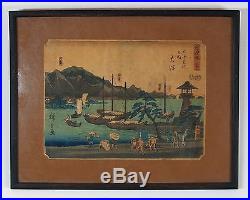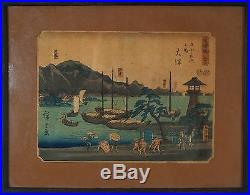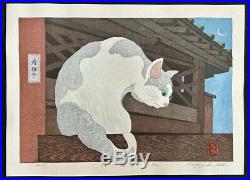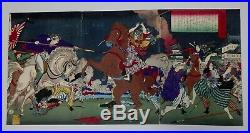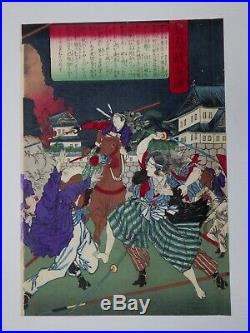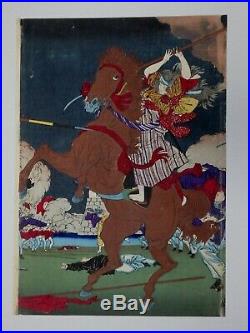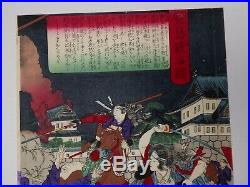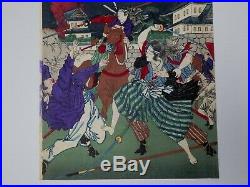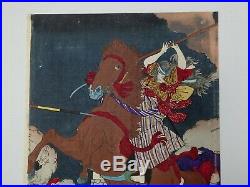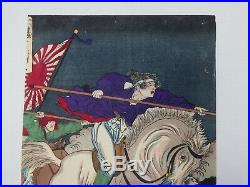From the series: The Tokaido Road-Fifty-tree stations. Print framed under glass. He is particularly known for his scenes featuring snow and rain, which feauture in many of his best and most famous images, and which has led to his becoming know as “the artist of rain, snow and mist”. He was born (with the name Ando Tokutaro) in Edo (the name of Tokyo at that point in time), and originally was intended to follow the career of his father, a fire-watchman. After his parents’ death in 1809, the orphan Hiroshige gravitated toward the art world, an inclination which had been encouraged by his father. In 1811, he became a pupil of the woodblock artist Toyohiro, who had been a fellow-pupil with the great woodblock master Tokokuni under Toyoharu (all of the Utagawa school, the latter being the founder). In 1812 he was formally adopted into the Utagawa school, with the name Utagawa Hiroshige. He continued to hold his post as a fire-watchman, though, until 1823. In the early 1830′s, he started to discover himself as an artist, starting on the landscapes which became his forte, and changing his signature to Ichiyusai (sometimes Ichiryusai). His first landscape series was in 1829 or 1830, entitled “Eight Famous Views of Omi”, followed by a ten-print series “Famous Places of the Eastern Capital”, which in addition to showing the influence of Hokusai, also marked the first revelations of Hiroshige’s true genius. In 1832 he made his first journey down the Tokaido highway, which resulting in his first great artistic success, the original “Fifty-Three Stations of the Tokaido”, a series which catapulted him to contemporary fame and success. This series is is now also universally held among the greatest of all Japanese landscape prints, and one of the two best series he ever did. For the next twenty years, he continued to produce large numbers of landscape and other series, but principally landscapes, on a large number of different themes. Chief among them are a large number of other Tokaido series, among them so-called “Gyosho Tokaido”, the “Reisho Tokaido”, and the “Upright Tokaido” (the original, above, being commonly known as the “Hoeido Tokaido”, after the publisher). Also found fairly often, and of some artistic note, is the so-called “Upright Tokaido” 1855, in which the print is oriented in portrait mode (or tateban), not landscape (or yokoban), as are the other three series above. Other notable landscape series included “Famous Places of Kyoto”; a large number of different series on famous places in Edo; the “Sixty-Nine Stages of the Kisokaido” (the inland mountain road from Edo to Kyoto, as opposed to the Tokaido, which ran along the shore); “Famous Places in the Sixty-Odd Provinces”; “Eight Views of Lake Biwa”; and “Thirty-Six Views of Mount Fuji”. His last great landscape series, the “Famous Places of Edo: A Hundred Views” (often called the “Hundred Views of Edo”) was produced right up until Hiroshige’s death, and is now considered one of his two best series, along with the original “Fifty-Three Stations of the Tokaido”. It is approximately : 6 1/2 x 8 3/4 (16,5 cm x 22,5 cm) v. 10 x 12 1/2. (25 cm x 31,5 cm) Framed. Verall good condition considering the age. Please look at pictures. The item “Utagawa Hiroshige (1797-1858) Otsu WOODBLOCK PRINT” is in sale since Tuesday, January 3, 2017. This item is in the category “Antiques\Asian Antiques\Japan\Prints”. The seller is “hourestate” and is located in Pikesville, Maryland. This item can be shipped worldwide.
- Type: Paintings, Scrolls & Prints
- Primary Material: Paper
- Region of Origin: Japan
- Original/Reproduction: Original
- Age: 1850-1899
- Maker: Utagawa Hiroshige
- Color: Blue
